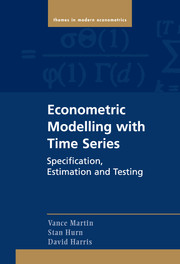Book contents
- Frontmatter
- Contents
- List of Illustrations
- Computer Code Used in the Examples
- Preface
- PART ONE Maximum Likelihood
- PART TWO Regression Models
- PART THREE Other Estimation Methods
- PART FOUR Stationary Time Series
- PART FIVE Nonstationary Time Series
- PART SIX Nonlinear Time Series
- 19 Nonlinearities in Mean
- 20 Nonlinearities in Variance
- 21 Discrete Time Series Models
- Appendix A Change of Variable in Density Functions
- Appendix B The Lag Operator
- Appendix C FIML Estimation of a Structural Model
- Appendix D Additional Nonparametric Results
- References
- Author Index
- Subject Index
21 - Discrete Time Series Models
from PART SIX - Nonlinear Time Series
Published online by Cambridge University Press: 05 January 2013
- Frontmatter
- Contents
- List of Illustrations
- Computer Code Used in the Examples
- Preface
- PART ONE Maximum Likelihood
- PART TWO Regression Models
- PART THREE Other Estimation Methods
- PART FOUR Stationary Time Series
- PART FIVE Nonstationary Time Series
- PART SIX Nonlinear Time Series
- 19 Nonlinearities in Mean
- 20 Nonlinearities in Variance
- 21 Discrete Time Series Models
- Appendix A Change of Variable in Density Functions
- Appendix B The Lag Operator
- Appendix C FIML Estimation of a Structural Model
- Appendix D Additional Nonparametric Results
- References
- Author Index
- Subject Index
Summary
Introduction
In most of the models previously discussed, the dependent variable, yt, is assumed to be a continuous random variable. There are a number of situations where the continuity assumption is inappropriate and alternative classes of models must be specified to explain the time series features of discrete random variables. This chapter reviews the important class of discrete time series models commonly used in microeconometrics namely the probit, ordered probit and Poisson regression models. It also discusses some recent advances in the modelling of discrete random variables with particular emphasis on the binomial thinning model of Steutel and Van Harn (1979) and the Autoregressive Conditional Duration (ACD) model of Engle and Russell (1998), together with some of its extensions.
Motivating Examples
Recent empirical research in financial econometrics has emphasised the importance of discrete random variables. Here, data on the number of trades and the duration between trades are recorded at very high frequencies. The examples which follow all highlight the need for econometric models that deal with discrete random variables by preserving the distributional characteristics of the data.
Example 21.1 Transactions Data on Trades
Table 21.1 provides a snapshot of transactions data recorded every second, on the United States stock AMR, the parent company of American Airlines, on 1 August 2006. Three examples of discrete random variables can be obtained from the data in Table 21.1.
- Type
- Chapter
- Information
- Econometric Modelling with Time SeriesSpecification, Estimation and Testing, pp. 812 - 848Publisher: Cambridge University PressPrint publication year: 2012



